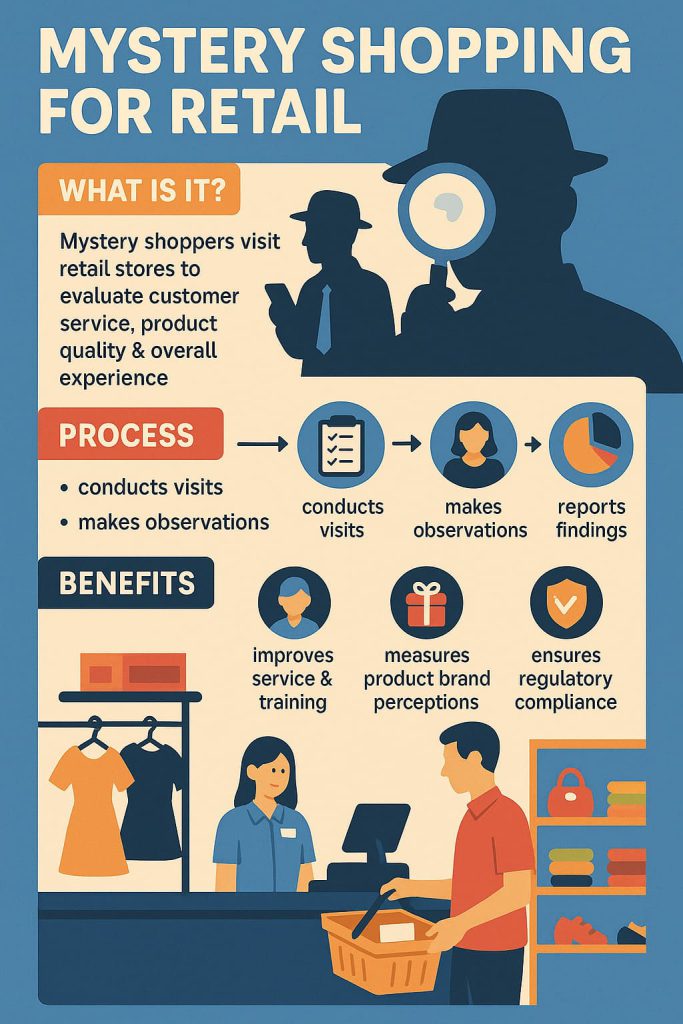Mystery Shopping for Retail

The retail battlefield has never been bloodier… While marketing teams blast Instagram with perfectly curated content, 68% of brands are losing customers at the front lines without even realizing it. Mystery shopping for retail is the strategic radar system most companies desperately need but stubbornly avoid.
Table of Contents
✅ Listen to this PODCAST EPISODE here:
The Sobering Reality Check Every Retailer Needs
- $600 Million Delusion: Mystery shopping for retail represents the largest segment of a $600 million US industry. But, most of this spending delivers zero ROI because companies collect data they’ll never actually use.
- The Silent Exodus: Over 90% of unhappy retail customers never complain. They simply vanish. They’re ghosting brands right now while executives obsess over Instagram engagement metrics.
- Intelligence Revolution: Traditional mystery shopping for retail with clipboards and checklists? Forward-thinking brands now deploy machine learning algorithms that analyze emotional micro-expressions staff don’t even know they’re making.
- Legal Espionage: The smartest retailers are systematically dissecting competitors through structured mystery shopping for retail, stealing what works, and avoiding what doesn’t.
- Real-Time or Dead: By 2025, waiting 2-3 weeks for mystery shopping reports will be retail suicide. Winners are already using real-time mystery shopping for retail systems that address issues within hours, not months.
Most Mystery Shopping for Retail Programs Fail
Mystery shopping for retail programs consistently deliver zero value. Not because mystery shopping doesn’t work, but because most organizations are structurally incapable of using it effectively.
Retailers with significant customer experience problems typically have entrenched cultural and leadership issues that make them resistant to the very insights that could save them. Meanwhile, brands already delivering exceptional experiences are psychologically open to feedback and quick to implement improvements – even though they need it less.
It’s a cruel paradox that explains why so many mystery shopping for retail initiatives crash and burn.
The most revealing pattern in modern retail is how organizational hierarchy distorts customer experience reality. In rigidly hierarchical organizations, negative mystery shopping findings get progressively filtered and diluted as they move up the chain. By the time they reach decision-makers, they’ve been sanitized beyond recognition.
But that’s just the beginning of the dysfunction.
Even when unfiltered insights reach leadership, cognitive dissonance kicks in. Retail executives receiving devastating ミステリーショッピング results perform Olympic-level mental gymnastics to explain why the methodology must be flawed. One national retailer memorably declared, “These shoppers clearly caught us on unusually busy days” – after reviewing two years of consistently negative evaluations across 74 locations.
The organizational psychology explains everything about failed mystery shopping for retail. Most retailers have built their identity around being customer-focused. When mystery shopping reveals significant gaps between this identity and reality, it triggers an existential threat response. The organization mobilizes its immune system to attack, discredit, or neutralize the threatening information rather than metabolize it.
This psychological reality requires a complete rethinking of how mystery shopping for retail programs should be designed and implemented. The traditional approach focuses almost exclusively on methodology – what to measure and how to measure it. But the breakthrough insight is that implementation psychology matters far more than methodology.
The Mystery Shopping for Retail Methods That Actually Deliver Results

In-Store Evaluation: The Crucial Foundation Most Retailers Get Catastrophically Wrong
Unfortunately, most brands have absolutely no idea what’s happening on their front lines.
Sure, they have KPIs and dashboards and all those lovely metrics that create the illusion of control.. But most have never experienced their brand as customers actually do, and their mystery shopping for retail programs are too superficial to show them.
Instead of checking compliance boxes, focus on evaluating the psychological dimensions that actually drive purchase decisions:
1. Trust Velocity
How quickly does staff establish authentic credibility with customers? The most sophisticated mystery shopping for retail programs recognize that customers make subconscious trust assessments within seconds of interaction – long before any actual information is exchanged.
These evaluations assess specific trust-building behaviors: making genuine eye contact, demonstrating attentiveness, matching communication styles, establishing relevant expertise, and acknowledging customer needs before pushing products.
2. Friction Elimination
Where do unnecessary obstacles exist in the customer journey? Behavioral economics reveals that effort reduction drives customer loyalty more powerfully than feature enhancement, yet most retailers focus on the latter while ignoring the former.
Advanced mystery shopping for retail identifies and quantifies friction points: navigation challenges, product access barriers, information gaps, checkout bottlenecks, and policy hurdles that create customer effort. These friction audits reveal immediate improvement opportunities that simultaneously enhance customer experience and reduce operational costs.
3. Emotional Resonance
Does staff create authentic connection or just mechanically complete transactions? The psychological distinction between interaction and connection is crucial yet rarely measured in traditional mystery shopping for retail.
Breakthrough programs evaluate specific emotionally resonant behaviors: personalizing interactions, finding common ground, demonstrating genuine interest, adapting to emotional cues, and creating moments of delight that transform transactional experiences into memorable ones.
Digital-Physical Integration: The Missing Element Killing Retail Brands
Customers don’t think in channels. They don’t separate their “online experience” from their “in-store experience.” They just have experiences with brands.
Yet most ミステリーショッピング for retail programs evaluate channels in isolation, completely missing the critical integration points where customer journeys actually break down.
The retailers gaining competitive advantage implement mystery shopping for retail programs that explicitly evaluate cross-channel transitions:
1. Research-to-Purchase Journeys
The most common omnichannel journey involves online research followed by in-store purchase. Advanced mystery shopping for retail evaluates how seamlessly customers can move from digital research to physical completion, assessing whether in-store staff can access and leverage the customer’s digital history to create continuity rather than starting from zero.
2. Cross-Channel Consistency
Psychological research shows that inconsistency creates cognitive dissonance that erodes brand trust more powerfully than consistently mediocre experiences. Leading retailers deploy mystery shopping for retail to assess consistency across channels: pricing alignment, promotional continuity, product availability, and policy application.
3. Channel-Shifting Capability
The most sophisticated omnichannel retailers enable customers to shift channels mid-journey without friction. Effective mystery shopping for retail evaluates how seamlessly these transitions occur: can store associates access online orders? Can customers easily move from app to store to phone support without repeating information? Can digital orders be modified in-store without complications?
The Psychology of Effective Implementation for Mystery Shopping for Retail
The retailers extracting maximum value from ミステリーショッピング for retail share several counterintuitive implementation practices that dramatically outperform conventional approaches:
1. They separate measurement from judgment
Most retailers make a catastrophic psychological error with mystery shopping for retail – they use scores to judge performance rather than understand it. This instantly creates defensive responses that block actual improvement.
The breakthrough retailers establish a fundamentally different psychological contract. They position mystery shopping for retail as a diagnostic tool to understand system performance rather than a weapon to evaluate individual performance.
2. They investigate patterns, not incidents
Average retailers obsess over individual mystery shopping evaluations – particularly negative ones. They launch investigations, identify “what went wrong,” implement narrow fixes for specific incidents, and then wonder why system performance doesn’t improve.
Superior retailers ignore individual evaluations and focus exclusively on patterns across hundreds or thousands of data points from mystery shopping for retail. They understand that customer experience is an emergent property of complex systems rather than a series of isolated incidents.
3. They create insight democracy rather than insight aristocracy
In most retail organizations, mystery shopping insights stop at middle management. Frontline employees – those actually creating the customer experience – receive simplified scorecards or watered-down findings rather than rich, contextual understanding.
The retailers achieving breakthrough results demolish this insight hierarchy. They share complete, unfiltered mystery shopping for retail insights with everyone from the CEO to frontline staff.
4. They focus on driver metrics, not outcome metrics
Traditional mystery shopping for retail programs emphasize outcome metrics – overall satisfaction, likelihood to recommend, etc. These create virtually no actionable intelligence because they describe results without illuminating causes.
The most effective retailers ruthlessly focus on driver metrics – the specific operational, behavioral, and psychological factors that create customer experience outcomes. They use sophisticated statistical analysis of mystery shopping for retail data to identify which elements most directly influence customer perceptions, then concentrate improvement efforts on these high-leverage factors.
These implementation practices transcend methodology. Retailers with basic mystery shopping approaches achieve breakthrough results through superior implementation, while companies with sophisticated methodologies fail completely due to implementation deficiencies.
The inescapable conclusion? Stop obsessing over methodology and start focusing on implementation psychology in mystery shopping for retail.
The Future of Mystery Shopping for Retail
The mystery shopping for retail landscape is experiencing tectonic shifts that will render current approaches obsolete within 2-3 years. The brands gaining competitive advantage are those already implementing tomorrow’s approaches while their competitors cling to yesterday’s methodologies.
The Convergence Revolution: Beyond Traditional Mystery Shopping for Retail
The most profound transformation happening in retail ミステリーショッピング is the convergence of multiple data streams into unified customer intelligence systems. Leading retailers no longer view mystery shopping as a standalone methodology but as one component in an integrated intelligence ecosystem.
This convergence integrates mystery shopping for retail data with:
- Customer feedback metrics (NPS, CSAT, CES)
- Behavioral analytics (conversion rates, dwell time, navigation patterns)
- Social sentiment analysis (review platforms, social channels)
- Operational data (staff scheduling, inventory levels, transaction volumes)
The retailers implementing these converged systems are dramatically outperforming those still treating mystery shopping for retail as an isolated evaluation method. They’re identifying experience breakdowns before they impact customer metrics and implementing targeted interventions with predictable financial outcomes.
The Technology Evolution: AI-Enhanced Mystery Shopping for Retail
AI is fundamentally reshaping how mystery shopping data is collected, analyzed, and applied in retail environments. The emerging approaches leverage AI not to replace human evaluators but to enhance their capabilities and extract deeper insights from their observations in mystery shopping for retail.
The most significant AI applications include:
1. Natural Language Processing for Sentiment Analysis
Advanced NLP systems now analyze narrative feedback from mystery shopping for retail to identify emotional patterns and subtleties invisible to traditional scoring methods. These systems detect nuanced emotional states like confusion, frustration, or enthusiasm that numeric ratings consistently miss.
2. Computer Vision for Environmental Analysis
Computer vision technology now supplements mystery shopper observations with objective environmental analysis. Evaluators can capture images of store conditions, displays, and signage, which AI systems then analyze for compliance, consistency, and visual impact in mystery shopping for retail.
3. Pattern Recognition for Predictive Insights
Machine learning algorithms now identify patterns across thousands of mystery shopping for retail evaluations to predict future customer behavior. These systems reveal which specific service elements most reliably predict customer satisfaction, loyalty, and spend, enabling retailers to prioritize improvements with maximum financial impact.
4. Real-Time Feedback Systems

Key Takeaways:
✅ Mystery shopping for retail is simultaneously the most undervalued and most poorly implemented customer intelligence system in modern business.
✅ Implementation psychology—not methodology—separates market leaders from laggards in mystery shopping for retail effectiveness.
✅ The most successful mystery shopping for retail programs focus on understanding systems rather than judging individuals, prioritizing patterns over isolated incidents.
✅ Retail organizations leveraging mystery shopping as strategic intelligence consistently outperform those using it merely as a compliance tool.
✅ Technological integration (AI, biometrics, predictive analytics) is making traditional mystery shopping for retail approaches obsolete.
✅ Despite technological advances, the fundamental success factor remains organizational readiness to confront uncomfortable truths.
✅ The future of mystery shopping for retail belongs to organizations that view customer experience as a complex adaptive system requiring sophisticated intelligence capabilities.
What Makes SIS International a Top Mystery Shopping Provider for Retail?
Most mystery shopping providers make identical empty promises… What makes SISインターナショナル the standout choice for retailers that actually want transformative insights rather than checkbox exercises?
- Retail-Specific Methodology Architects: Most providers force retailers into their standardized approach to mystery shopping for retail. SIS does the opposite – designing bespoke research methodologies around specific retail models, customer journeys, and operational realities.
- Four Decades of Retail Pattern Recognition: SIS brings over 40 years of accumulated wisdom in retail environments. That’s not just about experience – it’s about having observed retail customer behavior through multiple economic cycles, technological revolutions, and psychological shifts in mystery shopping for retail.
- Demographically-Targeted Shopper Engine: The dirty secret in mystery shopping for retail? Most providers struggle to find qualified evaluators who actually match customer profiles. SIS maintains proprietary recruitment databases that ensure evaluators who actually represent target customer demographics and can provide relevant insights, not whoever happened to respond to a Craigslist ad.
- Omnichannel Integration Mastery: Unlike providers who evaluate physical and digital retail experiences in isolation, SIS excels at analyzing the critical integration points where most customer journeys actually break down.
- Actionable Analytics That Actually Reveal Something: If mystery shopping for retail reports are filled with meaningless aggregate scores and surface-level observations, that’s a sign of working with the wrong provider. SIS leverages advanced analytics to identify correlation patterns, psychological drivers, and predictive indicators that transform raw observations into strategic intelligence organizations can actually use.
- Implementation Support Systems: Most providers think their job ends with delivering a report. SIS recognizes that insights without implementation create zero value in mystery shopping for retail. Our expertise in retail customer research includes structured implementation frameworks that help retail organizations convert insights into operational improvements – the critical step most providers completely ignore.
- Competitive Intelligence Integration: Understanding performance in isolation is virtually meaningless. SIS integrates mystery shopping for retail with broader 市場情報 to provide competitive context for findings, helping understand how customer experience compares to competitors rather than evaluating it in a vacuum.
よくある質問
Isn’t mystery shopping for retail just spying on employees?
The distinction lies in intention and transparency. When mystery shopping for retail is implemented as a mechanism to catch employees violating policies, it creates a toxic surveillance culture. When positioned as a system improvement tool and implemented with full transparency about methodology and purpose, it builds rather than erodes organizational trust.
The ethical bright line? Mystery shopping for retail should evaluate the effectiveness of systems, not judge the performance of individuals. The moment it becomes a weapon in performance management, it loses both ethical standing and practical effectiveness.
What certifications or standards actually matter when selecting a retail mystery shopping provider?
The Mystery Shopping Professionals Association (MSPA) provides baseline legitimacy for providers, but membership alone reveals almost nothing about capability. Many member companies deliver mediocre mystery shopping for retail while following all standards, while some non-member boutique firms produce extraordinary insights without formal certification.
The certifications that actually predict provider quality in mystery shopping for retail aren’t industry-specific but methodology-related: advanced training in research design, statistical analysis, behavioral psychology, and systems thinking. These capabilities matter far more than retail-specific certifications.
The most reliable quality indicator? The provider’s ability to articulate how they translate raw observations into actionable intelligence for retail environments. This capability predicts program effectiveness more accurately than any formal certification for mystery shopping for retail.
Can online retail experiences really be effectively mystery shopped?
Yes, but the methodological requirements differ dramatically from physical evaluations, and most providers haven’t adapted appropriately for mystery shopping for retail e-commerce.
The central challenge in digital mystery shopping for retail isn’t methodology but matching. Physical mystery shoppers can reasonably approximate the demographic and behavioral characteristics of actual customers. Digital mystery shoppers often cannot replicate the device environments, browsing patterns, and purchase histories that shape personalized digital experiences in modern retail.
The most sophisticated digital mystery shopping for retail programs address this challenge through technical environment replication – creating digital personas with browsing histories, device characteristics, and behavior patterns that mirror actual customer segments. This requires technical capabilities most traditional mystery shopping providers simply don’t possess.
How frequently should mystery shopping for retail evaluations be conducted?
The conventional wisdom suggests consistent monthly or quarterly evaluations across all locations. This calendar-driven approach to mystery shopping for retail is methodologically convenient but strategically misguided.
The breakthrough approach implements dynamic frequency based on performance variability rather than calendar convenience. Retail locations demonstrating high performance consistency might receive quarterly evaluations, while those showing significant variance or underperformance receive monthly or even weekly assessments.
What’s the actual ROI calculation for mystery shopping for retail programs?
Most providers offer simplistic ROI calculations based on speculative improvements in retail conversion rates or retention. These models lack statistical validity and create unrealistic expectations about mystery shopping for retail.
The accurate approach requires isolating the specific performance improvements attributable to mystery shopping insights, then calculating their financial impact on retail metrics. This methodological rigor reveals that well-implemented programs typically deliver 300-700% ROI, while poorly implemented mystery shopping for retail programs frequently produce negative returns regardless of methodology.
ニューヨークの施設所在地
11 E 22nd Street、2階、ニューヨーク、NY 10010 電話: +1(212) 505-6805
SISインターナショナルについて
SISインターナショナル 定量的、定性的、戦略的な調査を提供します。意思決定のためのデータ、ツール、戦略、レポート、洞察を提供します。また、インタビュー、アンケート、フォーカス グループ、その他の市場調査方法やアプローチも実施します。 お問い合わせ 次の市場調査プロジェクトにご利用ください。


